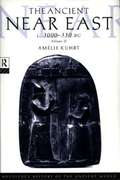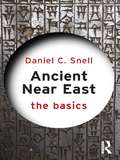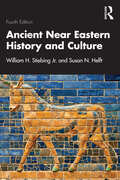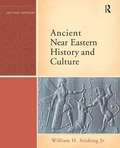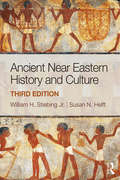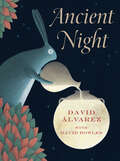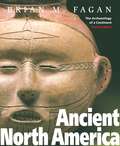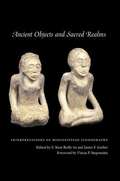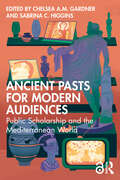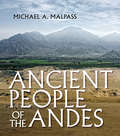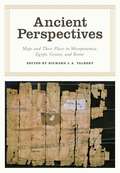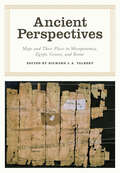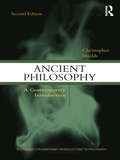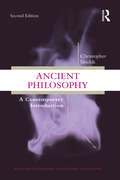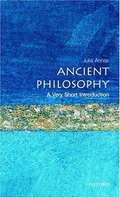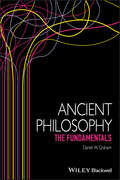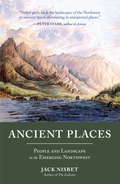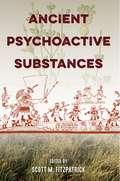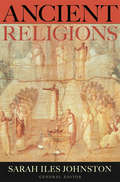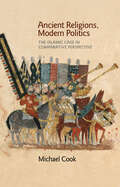- Table View
- List View
Ancient Near East c. 3000-330 BC Volume 2
by Amélie KuhrtThe ancient Near East embraces a vast geographical area, from the borders of Iran and Afghanistan in the east to the Levant and Anatolia, and from the Black Sea in the north to Egypt in the south. In this authoritative study, Amelie Kuhrt examines its history from the earliest written documents to the conquest of Alexander the Great, c. 3000-330 B. C. It provides a lucid, up-to-date narrative which takes into account the latest archaeological and textual discoveries and deals with the complex problems of interpretation and methodology.
Ancient Near East: The Basics (The Basics)
by Daniel C. SnellAncient Near East: The Basics surveys the history of the ancient Middle East from the invention of writing to Alexander the Great’s conquest. The book introduces both the physical and intellectual environment of those times, the struggles of state-building and empire construction, and the dissent from those efforts. Topics covered include: What do we mean when we talk about the Ancient Near East? The rise and fall of powerful states and monarchs Daily life both in the cities and out in the fields The legacy of the Ancient Near East: religion, science and writing systems. Featuring a glossary, chronology and suggestions for further reading, this book has all the tools the reader needs to understand the history and study of the Ancient Near East.
Ancient Near Eastern History and Culture
by Susan N. Helft William H. Stiebing Jr.Ancient Near Eastern History and Culture offers an historical overview of the civilizations of the ancient Near East spanning ten thousand years of history. This new edition is a comprehensive introduction to the history and culture of the Near East, from prehistory and the beginnings of farming to the fall of Achaemenid Persia. Through text, images, maps, and historical documents, readers discover the material, social, and political world of cultures from Egypt to India, allowing students to see how these intertwined cultures interacted throughout history. Now fully updated and incorporating the latest scholarship on society, religion, and the economy, this book highlights the changing fortunes of these great civilizations. A special feature of this book is its many "Debating the Evidence" sections, where the reader becomes familiar with scholarly disputes concerning the interpretation of textual and archaeological evidence on a variety of topics and case studies. The fourth edition of Ancient Near Eastern History and Culture remains a crucial textbook for undergraduates and general readers studying the ancient Near East, particularly the political and social history of ancient Egypt and Mesopotamia, as well as students of archaeology and biblical studies who are working on the region.
Ancient Near Eastern History and Culture
by William H. Stiebing Jr.This introduction to the Ancient Near East includes coverage of Egypt and a balance of political, social, and cultural coverage. Organized by the periods, kingdoms, and empires generally used in Near Eastern political history, the text interlaces social and cultural history with the political narrative. This combination allows students to get a rounded introduction to the subject of Ancient Near Eastern history. An emphasis on problems and areas of uncertainty helps students understand how evidence is used to create interpretations and allows them to realize that several different interpretations of the same evidence are possible.This introduction to the Ancient Near East includes coverage of Egypt and a balance of political, social, and cultural coverage.
Ancient Near Eastern History and Culture (3rd Edition)
by William H. Stiebing Jr. Susan N. Helft<p>Organized by the periods, kingdoms, and empires generally used in ancient Near Eastern political history, Ancient Near Eastern History and Culture interlaces social and cultural history with a political narrative. Charts, figures, maps, and historical documents introduce the reader to the material world of the ancient Near East, including Egypt. The emphasis on historical debates and areas of uncertainty helps students understand how historians use evidence to create interpretations and that several different interpretations of history are possible. New features in this edition include: <p> <li>Reorganization of the chapters on the early periods, with discussions incorporating the latest archaeological finds. <li>New "Debating the Evidence" sections discussing current controversial issues in Near Eastern history. These sections make it easy for students and teachers to find and use the portions of the text devoted to scholarly arguments about various aspects of ancient Near Eastern history. <li>A new chapter, "Ancient Israel and Judah," has been added to cover more completely the crucial issues of ancient Israelite history and religion. <li>More emphasis has been placed on the role and contributions of women in the ancient Near East.</li> <p> <p>The most important change is the addition of co-author Susan N. Helft, a specialist in the art and archaeology of the ancient Near East, who has applied her considerable knowledge, insight, research, and editing skills throughout the book. This new edition of Ancient Near Eastern History and Culture will remain a crucial text for students beginning to learn about the fascinating civilizations of the Near East.</p>
Ancient Night
by David BowlesPublishers Weekly Best of the Year BookPage Best of the Year Junior Library Guild Gold Standard Evanston Library Best of the Year Horn Book 2023 Summer Reading List "Vivid and vibrant." —NPR Weekend Edition At the start of things, the elders say, the universe was hushed and still. The moon alone shone bright and round in the star-speckled dark of the sky. David Álvarez is one of the most extraordinary artists working today. His black-and-white illustrations have gained fame in his home country of Mexico and around the world. Here, in Ancient Night (Noche Antigua), David displays his immense talent with full-color illustrations for the first time. Ancient Night is a twist on two Nahuatl traditions: the rabbit which the Feathered Serpent placed on the moon, and Yaushu, the Lord Opossum who ruled the earth before humans came, and who stole fire from the gods to create the sun. Award-winning author David Bowles has written a poetic text – and carefully researched backmatter – to accompany David’s lush illustrations and story. Published simultaneously in English and Spanish editions, Ancient Night offers young readers everywhere the chance to savor this ancient tale in its most beautiful format possible. P R A I S E A Junior Library Guild Gold Standard ★ "Bolstered by the ethereal, whimsical text, the plush, incandescent acrylic and oil paint artwork gathers the subtleties and splendors of nighttime and the plant life that surrounds Rabbit and Opossum. Together words and images tug readers along at a measured pace. An excellent authors’ note underscores how common strands and crucial differences from wide-ranging Mesoamerican legends and myths furnish the inspiration at the roots of this tale. Like a mighty dream recalled from time gone by." —Kirkus (starred) ★ "Luminous acrylic and oil illustrations bring the night to life... Enchanting text presents the tale in short, clear sentences that convey a sense of timeless mystery and beauty... An excellent choice for picture book collections that uniquely explores traditional Mesoamerican tales and is sure to inspire the wish for further discovery and appreciation." —School Library Journal (starred) ★ "Bowles’ spare, evocative text flows like poetry… Álvarez’s compositions are sophisticated and uncluttered… beautifully crafted, gently stylized figures so remarkably textured that you can almost count the number of hairs on Rabbit’s body. Ancient Night is wondrous, sparkling and easily one of the best picture books of 2023." —BookPage (starred) ★ "Bowles’s unhurried lines offer a playfully elegant feel to the telling, while Álvarez’s saturated digitized paintings use a limited palette to imagine long-eared, gray Rabbit and pointy-nosed, rust-hued Opossum against luminous leafy landscapes. Together, the collaborators create a dreamlike story variation that truly shines." —Publishers Weekly (starred) ★ "Unmissable… The breathtaking illustrations exude light themselves…" —Foreword Reviews (starred) ★ "Stunning illustrations by acclaimed Mexican artist Álvarez feature a velvety black backdrop of a sky, stars providing only pinpricks of light...spellbinding, poetic text is lyrical but crisp." —Horn Book (starred) "A calming selection for evening lap reads and storytimes." —BCCB "A perfect bedtime read aloud. This Mesoamerican-inspired fable borrows from old tales for a larger-than-life yet soothingly illustrated picture book." —Shelf-Awareness "Exquisite." —Melissa Taylor, Imagination Soup "Álvarez’s illustrations alone are enough to make this stunning picture book a winner—the dreamy feel of the milky moonlight against the deep-dark night and the crisp simplicity of the animals and their world is masterful. When paired with interwoven traditional Mesoamerican tales of the magic and power of our lunar companion, the story sings, enchanting readers with its mystery and beauty. Don’t miss this one!" —Southe
Ancient North America: The Archaeology of a Continent (4th edition)
by Brian M. FaganAnarrative account of what is known of the diverse ancient societies of North America.
Ancient Objects and Sacred Realms: Interpretations of Mississippian Iconography
by James F. Garber F. Kent Reilly IIIBetween AD 900-1600, the native peoples of the Mississippi River Valley and other areas of the Eastern Woodlands of the United States conceived and executed one of the greatest artistic traditions of the Precolumbian Americas. Created in the media of copper, shell, stone, clay, and wood, and incised or carved with a complex set of symbols and motifs, this seven-hundred-year-old artistic tradition functioned within a multiethnic landscape centered on communities dominated by earthen mounds and plazas. Previous researchers have referred to this material as the Southeastern Ceremonial Complex (SECC). This groundbreaking volume brings together ten essays by leading anthropologists, archaeologists, and art historians, who analyze the iconography of Mississippian art in order to reconstruct the ritual activities, cosmological vision, and ideology of these ancient precursors to several groups of contemporary Native Americans. Significantly, the authors correlate archaeological, ethnographic, and art historical data that illustrate the stylistic differences within Mississippian art as well as the numerous changes that occur through time. The research also demonstrates the inadequacy of the SECC label, since Mississippian art is not limited to the Southeast and reflects stylistic changes over time among several linked but distinct religious traditions. The term Mississippian Iconographic Interaction Sphere (MIIS) more adequately describes the corpus of this Mississippian art. Most important, the authors illustrate the overarching nature of the ancient Native American religious system, as a creation unique to the native American cultures of the eastern United States.
Ancient Pasts for Modern Audiences: Public Scholarship and the Mediterranean World
by Chelsea A.M. Gardner and Sabrina C. HigginsThis volume brings together specialists from a broad demographic and professional range – academics, museum curators, students, and content creators – to discuss case studies, challenges, and potential future avenues for public scholarship on the history, archaeology, and cultures of the ancient Mediterranean, North Africa and Western Asia.Together, the contributions promote the creation of inclusive methods of knowledge mobilisation and communication in public spheres across three main areas: cultural heritage, pedagogy and public-facing scholarship. These areas have all been directly affected by Eurocentric structures that have claimed ownership of ancient Mediterranean cultural heritage and have dictated how it has been taught in schools and communicated to the broader public. The volume is divided into three sections – Museums, Teaching and Learning, and Global and Local Projects – each addressing pressing challenges faced within these interrelated fields and offering ways for us to overcome the exclusionary narratives that plague them.Ancient Pasts for Modern Audiences provides an invaluable resource for those interested in public history, from academics to lay audiences, in the fields of Ancient Mediterranean, North African, and Western Asian Studies. The book also appeals to professionals and researchers whose interests lie in public-facing scholarship, pedagogy, digital humanities, decolonisation studies, museum studies and popular media.The Open Access version of this book, available at http://www.taylorfrancis.com, has been made available under a Creative Commons Attribution-Non Commercial-No Derivatives (CC BY-NC-ND) 4.0 license.
Ancient People of the Andes
by Michael A. MalpassIn Ancient People of the Andes, Michael A. Malpass describes the prehistory of western South America from initial colonization to the Spanish Conquest. All the major cultures of this region, from the Moche to the Inkas, receive thoughtful treatment, from their emergence to their demise or evolution. No South American culture that lived prior to the arrival of Europeans developed a writing system, making archaeology the only way we know about most of the prehispanic societies of the Andes. The earliest Spaniards on the continent provided first-person accounts of the latest of those societies, and, as descendants of the Inkas became literate, they too became a source of information. Both ethnohistory and archaeology have limitations in what they can tell us, but when we are able to use them together they are complementary ways to access knowledge of these fascinating cultures. Malpass focuses on large anthropological themes: why people settled down into agricultural communities, the origins of social inequalities, and the evolution of sociopolitical complexity. Ample illustrations, including eight color plates, visually document sites, societies, and cultural features. Introductory chapters cover archaeological concepts, dating issues, and the region's climate. The subsequent chapters, divided by time period, allow the reader to track changes in specific cultures over time.
Ancient Persia
by Matt WatersThe Achaemenid Persian Empire, at its greatest territorial extent under Darius I (r. 522-486 BCE), held sway over territory stretching from the Indus River Valley to southeastern Europe and from the western Himalayas to northeast Africa. In this book, Matt Waters gives a detailed historical overview of the Achaemenid period while considering the manifold interpretive problems historians face in constructing and understanding its history. This book offers a Persian perspective even when relying on Greek textual sources and archaeological evidence. Waters situates the story of the Achaemenid Persians in the context of their predecessors in the mid-first millennium BCE and through their successors after the Macedonian conquest, constructing a compelling narrative of how the empire retained its vitality for more than two hundred years (c. 550-330 BCE) and left a massive imprint on Middle Eastern as well as Greek and European history.
Ancient Persia and Iranian Civilization
by Clement HuartOriginally published between 1920-70,The History of Civilization was a landmark in early twentieth century publishing. It was published at a formative time within the social sciences, and during a period of decisive historical discovery. The aim of the general editor, C.K. Ogden, was to summarize the most up to date findings and theories of historians, anthropologists, archaeologists and sociologists. This reprinted material is available as a set, in the following groupings, or as individual volumes: * Prehistory and Historical Ethnography Set of 12: 0-415-15611-4: £800.00 * Greek Civilization Set of 7: 0-415-15612-2: £450.00 * Roman Civilization Set of 6: 0-415-15613-0: £400.00 * Eastern Civilizations Set of 10: 0-415-15614-9: £650.00 * Judaeo-Christian Civilization Set of 4: 0-415-15615-7: £250.00 * European Civilization Set of 11: 0-415-15616-5: £700.00
Ancient Perspectives: Maps and Their Place in Mesopotamia, Egypt, Greece and Rome
by Richard J. A. TalbertAncient Perspectives encompasses a vast arc of space and time--Western Asia to North Africa and Europe from the third millennium BCE to the fifth century CE--to explore mapmaking and worldviews in the ancient civilizations of Mesopotamia, Egypt, Greece, and Rome. In each society, maps served as critical economic, political, and personal tools, but there was little consistency in how and why they were made. Much like today, maps in antiquity meant very different things to different people. Ancient Perspectives presents an ambitious, fresh overview of cartography and its uses. The seven chapters range from broad-based analyses of mapping in Mesopotamia and Egypt to a close focus on Ptolemy's ideas for drawing a world map based on the theories of his Greek predecessors at Alexandria. The remarkable accuracy of Mesopotamian city-plans is revealed, as is the creation of maps by Romans to support the proud claim that their emperor's rule was global in its reach. By probing the instruments and techniques of both Greek and Roman surveyors, one chapter seeks to uncover how their extraordinary planning of roads, aqueducts, and tunnels was achieved. Even though none of these civilizations devised the means to measure time or distance with precision, they still conceptualized their surroundings, natural and man-made, near and far, and felt the urge to record them by inventive means that this absorbing volume reinterprets and compares.
Ancient Perspectives: Maps and Their Place in Mesopotamia, Egypt, Greece, and Rome (The\kenneth Nebenzahl Jr. Lectures In The History Of Cartography Ser.)
by Richard J. A. TalbertAncient Perspectives encompasses a vast arc of space and time—Western Asia to North Africa and Europe from the third millennium BCE to the fifth century CE—to explore mapmaking and worldviews in the ancient civilizations of Mesopotamia, Egypt, Greece, and Rome. In each society, maps served as critical economic, political, and personal tools, but there was little consistency in how and why they were made. Much like today, maps in antiquity meant very different things to different people.Ancient Perspectives presents an ambitious, fresh overview of cartography and its uses. The seven chapters range from broad-based analyses of mapping in Mesopotamia and Egypt to a close focus on Ptolemy’s ideas for drawing a world map based on the theories of his Greek predecessors at Alexandria. The remarkable accuracy of Mesopotamian city-plans is revealed, as is the creation of maps by Romans to support the proud claim that their emperor’s rule was global in its reach. By probing the instruments and techniques of both Greek and Roman surveyors, one chapter seeks to uncover how their extraordinary planning of roads, aqueducts, and tunnels was achieved. Even though none of these civilizations devised the means to measure time or distance with precision, they still conceptualized their surroundings, natural and man-made, near and far, and felt the urge to record them by inventive means that this absorbing volume reinterprets and compares.
Ancient Philosophical Poetics
by Malcolm HeathWhat is poetry? Why do human beings produce and consume it? What effects does it have on them? Can it give them insight into truth, or is it dangerously misleading? This book is a wide-ranging study of the very varied answers which ancient philosophers gave to such questions. An extended discussion of Plato's Republic shows how the two discussions of poetry are integrated with each other and with the dialogue's central themes. Aristotle's Poetics is read in the context of his understanding of poetry as a natural human behaviour and an intrinsically valuable component of a good human life. Two chapters trace the development of the later Platonist tradition from Plutarch to Plotinus, Longinus and Porphyry, exploring its intellectual debts to Epicurean, allegorical and Stoic approaches to poetry. It will be essential reading for classicists as well as ancient philosophers and modern philosophers of art and aesthetics.
Ancient Philosophy: A Contemporary Introduction (Routledge Contemporary Introductions to Philosophy)
by Christopher ShieldsIn this re-titled and substantially revised update of his Classical Philosophy (2003), Christopher Shields expands his coverage to include the Hellenistic era, and now offers an introduction to more than 1,000 years of ancient philosophy. From Thales and other Pre-Socratics through Socrates, Plato, and Aristotle, and on to Epicureanism, Stoicism, and Scepticism, Ancient Philosophy traces the important connections between these periods and individuals without losing sight of the novelties and dynamics unique to each. The coverage of Plato and Aristotle also has been expanded. It now includes, for example, updated coverage of Plato's allegories of the cave and the divided line and the metaphor of the sun as well as features of Plato's epistemology. Shields also adds new discussion on Aristotle's theory of virtue and his approach to the Socratic problem of akrasia, or weakness of will. In terms of its structure, Ancient Philosophy is presented so that each philosophical position receives: (1) a brief introduction, (2) a sympathetic review of its principal motivations and primary supporting arguments, and (3) a short assessment, inviting readers to evaluate its plausibility. The result is a book that brings the ancient arguments to life, making the introduction truly contemporary. It will serve as both a first stop and a well visited resource for any student of the subject. Ancient Philosophy offers a vivid picture of the ideas that flourished at philosophy's long birth and considers their relevance, both to the historical development of the Western philosophical tradition, and to philosophy today.
Ancient Philosophy: A Contemporary Introduction (Routledge Contemporary Introductions to Philosophy)
by Christopher ShieldsIn Ancient Philosophy (2012), Christopher Shields expanded on the coverage of Socrates, Plato, and Aristotle in his earlier book, Classical Philosophy (2003), to include the philosophy of the Hellenistic era. In this new edition (2023), Shields reaches even further to include material on Neoplatonism and on Augustine and Proclus, capturing—from Thales of Miletus to the end of the sixth century CE—all of what might be called ancient philosophy. It traces the important connections between the periods and individuals of more than 1,200 years of philosophy’s history without losing sight of the novelties and dynamics unique to each. The coverage of the Presocratics, Sophists, Plato, and Stoicism has also been expanded so as to highlight Plato’s responses to the Sophistic movement in the development of his Theory of Forms. And, finally, a valuable companion volume, with Shields’s focused translations of the important sources referred to in Ancient Philosophy, Second Edition, will soon be published, obviating the need for a massive anthology of discordant voices. Ancient Philosophy, Second Edition, retains its helpful structure: each philosophical position receives: (1) a brief introduction, (2) a sympathetic review of its principal motivations and primary supporting arguments, and (3) a short assessment, inviting readers to evaluate its plausibility. The result is a book that brings the ancient arguments to life, making the introduction truly contemporary. It continues to serve as both a first stop and a well-visited resource for any student of the subject. Key updates in the second edition Extends the range of coverage well into the sixth century CE by offering a new chapter on Neoplatonism and early Christian philosophy, featuring discussions of Proclus and Augustine. Explains the conflicts between Plato and the Sophists by highlighting their approaches to rhetoric as an instrument of persuasion, offering a helpful explanation of two senses of argument. Includes new coverage of Plato’s argument from the Simplicity of the Soul, Argument from Affinity, and Argument against Rhetoric. Includes coverage of Aristotle’s political naturalism . May be used with a soon-to-be-published companion volume of primary source material, all of it translated by Christopher Shields specifically for the reader of this Second Edition.
Ancient Philosophy: A Very Short Introduction
by Julia AnnasA trenchant and provocative -- yet balanced and complete -- discussion of ancient philosophy and philosophers.
Ancient Philosophy: The Fundamentals (Fundamentals of Philosophy #26)
by Daniel W. GrahamA comprehensive yet accessible survey of ancient philosophy, covering Greek, Roman, and early Judeo-Christian philosophy, ideal for introductory courses in the ancient roots of modern worldviews Part of the popular Fundamentals of Philosophy series, Ancient Philosophy is an ideal resource for beginning students as well as for advanced students wishing to hone their understanding of the philosophies of the ancient world. Clear and engaging, this book covers a representative selection of major ancient thinkers, movements, and schools of thought, including the Sophists and other significant Presocratics, Socrates, Plato, Aristotle, Hellenistic philosophy, the Stoics, the Skeptics, and early Judeo-Christian philosophy up to Augustine. Written by a prominent scholar and author in ancient philosophy studies, this book: Provides an overview of important issues in the study of the philosophies of the ancient world Explores the relevance of the theories of ancient thinkers to the modern world Charts the progression in the ancient world from worldviews based in mythology to systems of thought based on the analysis of evidence Presents up-to-date scholarship as well as historical material from ancient sources Assumes no prior knowledge of philosophy and examines all arguments carefully and sequentially
Ancient Places
by Jack NisbetThese are the genesis stories of a region. In Ancient Places, Jack Nisbet uncovers touchstones across the Pacific Northwest that reveal the symbiotic relationship of people and place in this corner of the world. From rural Oregon, where a controversy brewed over the provenance and ownership of a meteor, to the great floods 15,000 years ago that shaped what is now Washington, Oregon, and Idaho, this is a compelling collection of stories about the natural and human history of our region.
Ancient Psychoactive Substances
by Scott M. Fitzpatrick"A well-founded and presented description of the integral role that psychoactive substances played in ancient societies. . . . A unique addition to ancient history collections."—Choice "Very informative, well referenced, and well illustrated."—Latin American Antiquity“A diverse and interesting introduction to the evidence for psychoactive use in the past, including consideration of the physical techniques and interpretative methods for understanding these practices.”—Journal of Psychedelic Studies "This well-researched and fascinating volume not only demonstrates the important cultural role of psychoactive substances in ancient societies but also points the way to an emerging research field. The unveiling of the past history of drug use becomes a lesson for present-day society."--Jan G. Bruhn, founding editor, Journal of Ethnopharmacology "Presents a broad overview of drug plants and fermented beverages by using anthropological, ethnological, archaeological, iconographic, chemical, and botanical approaches. Essential reading."--Elisa Guerra Doce, author of Drugs in Prehistory: Archaeological Evidence of the Use of Psychoactive Substances in Europe Mind-altering substances have been used by humans for thousands of years. In fact, ancient societies sometimes encouraged the consumption of drugs. Focusing on the archaeological study of how various entheogens have been used in the past, this volume examines why humans have social and psychological needs for these substances. Contributors trace the long-term use of drugs in ancient cultures and highlight the ways they evolved from being sacred to recreational in more modern times. By analyzing evidence of these substances across a diverse range of ancient cultures, the contributors explore how and why past civilizations harvested, manufactured, and consumed drugs. Case studies examine the use of stimulants, narcotics, and depressants by hunter-gatherers who roamed Africa and Eurasia, prehistoric communities in North and South America, and Maya kings and queens. Offering perspectives from many different fields of study, contributors illustrate the wide variety of sources and techniques that can provide information about materials that are often invisible to archaeologists. They use advanced biomolecular procedures to identify alkaloids and resins on cups, pipes, and other artifacts. They interpret paintings on vases and discuss excavations of breweries and similar sites. Uncovering signs of drugs, including ayahuasca, peyote, ephedra, cannabis, tobacco, yaupon, vilca, and maize and molle beer, they explain how psychoactive substances were integral to interpersonal relationships, religious practices, and social cohesion in antiquity. Scott M. Fitzpatrick, professor of archaeology at the University of Oregon, is coeditor of Island Shores, Distant Pasts: Archaeological and Biological Approaches to the Pre-Columbian Settlement of the Caribbean. Contributors: Quetta Kaye | Victor D. Thompson | Thomas J. Pluckhahn | Sean Rafferty | Mark Merlin | Matt Sayre | Constantino Manuel Torres | Zuzana Chovanec | Jennifer A. Loughmiller-Newman | Justin Jennings | Daniel M. Seinfeld | Shannon Tushingham | Scott M. Fitzpatrick
Ancient Religions
by Sarah Iles JohnstonReligious beliefs and practices, which permeated all aspects of life in antiquity, traveled well-worn routes throughout the Mediterranean: itinerant charismatic practitioners journeying from place to place peddled their skills as healers, purifiers, cursers, and initiators; and vessels decorated with illustrations of myths traveled with them. New gods encountered in foreign lands by merchants and conquerors were sometimes taken home to be adapted and adopted. This collection of essays by a distinguished international group of scholars, drawn from the groundbreaking reference work Religion in the Ancient World, offers an expansive, comparative perspective on this complex spiritual world.
Ancient Religions (Blackwell Ancient Religions Ser. #3)
by Sarah Iles JohnstonReligious beliefs and practices, which permeated all aspects of life in antiquity, traveled well-worn routes throughout the Mediterranean: itinerant charismatic practitioners journeying from place to place peddled their skills as healers, purifiers, cursers, and initiators; and vessels decorated with illustrations of myths traveled with them. New gods encountered in foreign lands by merchants and conquerors were sometimes taken home to be adapted and adopted. This collection of essays by a distinguished international group of scholars, drawn from the groundbreaking reference work Religions of the Ancient World, offers an expansive, comparative perspective on this complex spiritual world.
Ancient Religions, Modern Politics: The Islamic Case in Comparative Perspective
by Michael A. CookWhy Islam is more political and fundamentalist than other religionsWhy does Islam play a larger role in contemporary politics than other religions? Is there something about the Islamic heritage that makes Muslims more likely than adherents of other faiths to invoke it in their political life? If so, what is it? Ancient Religions, Modern Politics seeks to answer these questions by examining the roles of Islam, Hinduism, and Christianity in modern political life, placing special emphasis on the relevance—or irrelevance—of their heritages to today's social and political concerns.Michael Cook takes an in-depth, comparative look at political identity, social values, attitudes to warfare, views about the role of religion in various cultural domains, and conceptions of the polity. In all these fields he finds that the Islamic heritage offers richer resources for those engaged in current politics than either the Hindu or the Christian heritages. He uses this finding to explain the fact that, despite the existence of Hindu and Christian counterparts to some aspects of Islamism, the phenomenon as a whole is unique in the world today. The book also shows that fundamentalism—in the sense of a determination to return to the original sources of the religion—is politically more adaptive for Muslims than it is for Hindus or Christians.A sweeping comparative analysis by one of the world's leading scholars of premodern Islam, Ancient Religions, Modern Politics sheds important light on the relationship between the foundational texts of these three great religious traditions and the politics of their followers today.
Ancient Religions: A Guide (Blackwell Ancient Religions Ser. #8)
by Sarah Iles JohnstonReligious beliefs and practices, which permeated all aspects of life in antiquity, traveled well-worn routes throughout the Mediterranean: itinerant charismatic practitioners journeying from place to place peddled their skills as healers, purifiers, cursers, and initiators; and vessels decorated with illustrations of myths traveled with them. New gods encountered in foreign lands by merchants and conquerors were sometimes taken home to be adapted and adopted. This collection of essays by a distinguished international group of scholars, drawn from the groundbreaking reference work Religions of the Ancient World, offers an expansive, comparative perspective on this complex spiritual world.
